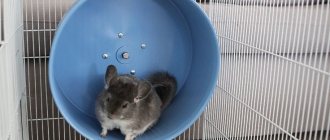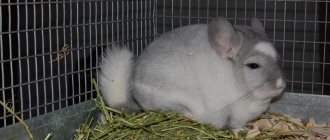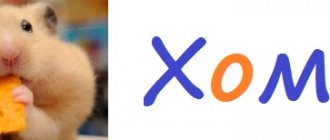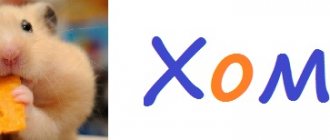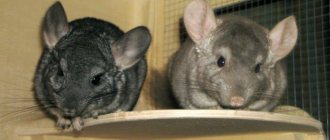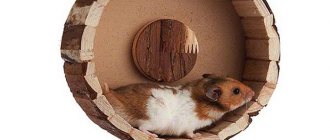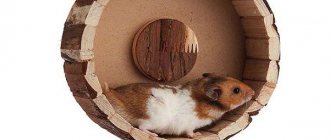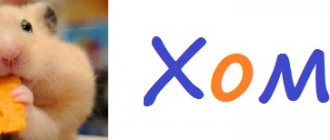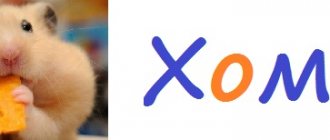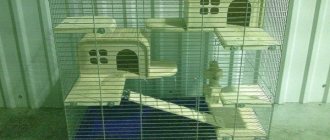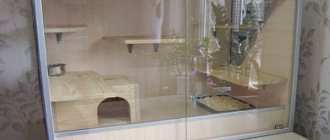Is there a need for a running wheel?
The answer to the question is simple - chinchillas need a wheel. There are good reasons for this.
Chinchillas are naturally active animals and tend to run, play and climb. The space of the home does not always allow for a play complex, and the owner may not have the opportunity to play with his pet every day. This situation will lead to the pet becoming lazy, its muscles will begin to atrophy.
Sedentary chinchillas are more likely to develop diseases and bad habits. Some diseases that begin with “laziness” lead to death.
In addition to health issues, for a chinchilla such a toy is a fun pastime and a guarantee of happiness. Every day, chinchillas run in a wheel; the presence of a structure in the house encourages them to take action. Usually a wheel is bought directly with a cage, without thinking about its functional features.
Hammock design
The design of a hammock for a chinchilla is simple. In the classic version, this is a piece of durable but pleasant-to-touch material, the corners of which are securely attached to the cage bars using carabiners or other fasteners.
Fabric structures differ favorably from other types in that they take a shape that matches the contours of the animal’s body, thereby providing maximum convenience and comfort. But if the animal gnaws its bed, you should choose other - more durable - materials.
As for the types of construction, there are two main types:
- single-tier (simple flat bed);
- two-tier or pipe-shaped (a volumetric hammock - the animal can be placed both on top and inside; climbing to the lower tier, the animal finds itself in a “house” - reliable and warm).
Which material is preferable
The design for active leisure can be made of different materials. When choosing which material to choose, you need to take into account environmental friendliness and safety.
There are basic materials, products from which are most often found in stores.
Plastic
Plastic is the material from which everything is made. Including wheels for pet rodents. Plastic wheels are durable, durable when fastened correctly, and do not absorb moisture.
The problem with choosing a plastic toy will arise only at the stage of selecting the size. Most often, plastic wheels are purchased for hamsters, and manufacturers deliberately make these designs too small for a larger rodent. It is almost impossible to find a product larger than 32 centimeters in diameter.
Thus, plastic is suitable for cubs, or small and light chinchillas; for large ones you will have to choose something larger.
Metal
The metal is famous for its strength and durability. For toys, metal is used that does not corrode.
But metal has a significant disadvantage - such wheels are dangerous. Their bottom is often made of mesh. While running, a chinchilla in a wheel runs the risk of becoming trapped, because its nail or finger can easily get stuck in the net.
You can get rid of the risk of injury by covering the bottom with thick fabric. However, this will not save you from injury if there is more than one rodent in the cage. One of them will certainly try to stick his head into the toy while the other is running. This happens if there is a wheel made of any material, however, there is no escape from a metal one - the material is quite heavy, and during rotational action it will certainly cause injury.
In addition, metal structures are quite unstable.
You can choose aluminum options that are attached to one of the walls of the cage/enclosure. There will be a problem with selecting the size, but you will not need to install an additional stand.
Tree
The wooden wheel option can be called ideal. The only disadvantage of wood is its ability to absorb moisture and odors. Getting rid of dirt on such structures will be problematic, if not impossible.
You can get rid of this problem by coating the surface of the toy with varnish. But the varnish tends to peel off, and it can get into your pet’s food. The consequences will be negative and this will not have a positive effect on the health of the rodent, so you should either put up with the smell and dirt or replace the toy often.
But there is also a significant advantage that makes wood an ideal material. It will be easy to find a toy of the right size. In each workshop you can order a toy of the required dimensions. Wheels made of wood are also quite stable and do not have a mesh or lattice bottom.
Hay
Hay is a versatile product that can be used not only as filler, but also as food. It has a pleasant aroma and natural composition.
Beast Moe meadow hay 0.6 kg/20 l
The product is made from dried meadow hay. The composition also includes field grasses, which are used as bedding. If necessary, hay can be used as feed. In this case, the product will saturate the pet’s body with useful substances, vitamins and other beneficial components.
The main benefit of hay is that it strengthens the immune system. In addition, the product gives the coat a natural look and healthy shine. Suitable for guinea pigs, reptiles, birds, rabbits, degas and chinchillas. The hay is stored in a secure package, which is secured with a metal clip. The filler is well compressed, so the pack contains only meadow herbs.
Advantages:
- environmentally friendly composition;
- pleasant smell of meadow herbs;
- the hay is cleared of dust;
- does not cause allergies;
- reliable packaging;
- economical consumption;
- good value for money;
- no fragrance;
- the hay is well compacted.
Flaws:
- does not absorb moisture well;
- sometimes there is dust in the composition;
- quality varies between batches;
- small variety of herbs.
Customer Reviews
Vitakraft VITA VERDE meadow hay with dandelion flowers 0.5 kg
The product is high in fiber. The hay contains dandelion flowers, timothy and meadow grasses. In addition, hay is low in calcium. Thanks to this, the product is not only tasty, but also healthy for your pet. Hay promotes optimal digestion and prevents abrasion of the incisors.
The filler also contains minerals, vitamins, micro- and macroelements. Thanks to this, your pet's immunity will increase. For hay, grasses that are subject to gentle drying are used. This provides healthy and natural nutrition.
But the main purpose of hay is as a filler. The product absorbs moisture well and masks unpleasant odors. In addition, hay is used economically.
Advantages:
- the hay is well compacted;
- pleasant aroma of meadow flowers and herbs;
- no fragrance;
- does not cause allergies;
- environmentally friendly composition;
- tight packaging;
- good value for money;
- economical consumption.
Flaws:
- sometimes there is dust in the composition;
- small variety of herbs.
Customer Reviews
What should the wheel size be?
When choosing the size of a running toy, you need to start from the size of the chinchilla itself. The larger the chinchilla, the larger the toy for it.
Usually wheels with a diameter of 32 centimeters are taken. A smaller size causes the chinchilla to bend and stumble when running. This leads to injuries: fractures and dislocations.
A large wheel will also be of little use - the chinchilla will not be able to accelerate it enough and in the end, will stop using it. The pet should be comfortable using the toy purchased/made for it.
Clothing, leashes and harnesses for chinchillas
The accessories for chinchillas presented in stores today are so diverse that they confuse breeders. The most controversial product is the leash with harness. It is strictly forbidden to walk chinchillas on the street. And there are several reasons for this:
- Chinchilla fur is easily damaged by any harness or collar,
- Chinchillas don't walk - they move by jumping. A collar can break your spine, a harness can break your ribs,
- There are quite a lot of dangerous bacteria, microbes, fungi,
- A sudden change of environment, new smells and sounds, bright light - all this will lead to very strong stress and can provoke a heart attack.
- A chinchilla is usually walked at home, but for home walks a harness and leash are not needed.
- In the same way, leashes and harnesses are not needed for exhibitions - the animal is placed from the carrier into the exhibition box.
Products for chinchillas include a variety of clothes: vests, jackets, shorts, overalls and dresses. There is no need to talk about the actual use of such accessories: you cannot leave an animal in clothes in a cage - in a few minutes the pet will chew everything it can reach and also get poisoned by the dyed fabric. At exhibitions, animals also do not need additional decorations. The downside is that the chinchilla is a freedom-loving animal, and it can be very difficult to persuade the animal to wear clothing that restricts movement.
How to make a running wheel for a chinchilla with your own hands
If the wheel was not purchased on the same day as the purchase of the cage, and the need for it was barely discovered, you should not rush headlong to the pet store. It is possible to make a wheel for a chinchilla from suitable materials. Homemade wheels are unlimited in diameter and are suitable for the individual living at home.
Of course, you will need some carpentry skills to make it. You will need to cut an even circle out of plywood and use a jigsaw to make a hole in its center. An even ring is cut out for the other side. Between the ring and the circle, planks are attached with self-tapping screws, which will form a running path. If desired, a lattice surface can be made by taking thin planks and attaching them not close to each other.
Next, a rotation unit is made. Bolts are suitable for this. It would be a good idea to choose a bolt that does not make a sound when turning. Fastening is carried out using a self-tapping screw and a wooden die.
Making a wheel for a chinchilla with your own hands means taking special care of your pet. A homemade design will be no worse in use than a store-bought one, will be cheaper in cost and will be absolutely safe if the materials are selected correctly and the work is done carefully.
A homemade toy is installed either by screwing it to the wall of the cage/enclosure, or by making a stand.
Varieties according to the method of fastening
There are three types of simulators for small pets:
- Mounted to the cage wall using wire or special holders. At the same time, such a simulator saves cellular space.
- Model on a stand. This option does not have good stability.
- A product with wheels on a stand is a safer design. In this case, the wheels are located on a stand.
- The running disc is equipped with a stable stand.
After a short period of use, the equipment may create extraneous noise. In this case, the metal structure can be lubricated with vegetable oil. Some masters create exercise machines with a generator. This device is used to charge a mobile phone.
To reduce noise, you can replace the plastic fastener with a bearing. In this case, the simulator will not make noise.
How to teach a chinchilla to run on a wheel
Usually the pet itself shows interest in a new thing in the cage/enclosure. If the dimensions of the toy are chosen correctly, it will be accurately examined and tested. Of course, provided that the wheel is already secured/installed.
If this did not happen, and the chinchilla did not show interest in the toy, there is no reason to panic or be upset. To begin with, the main thing is to introduce your pet to a new piece of furniture. You can spin the toy so that your pet understands what can be done with it and how to use it.
There is a high probability that a wooden toy will first be chewed and then tried. This is inevitable, but there is nothing wrong with it (unless, of course, the toy is varnished). This is how the animal gets used to the new environment.
Adults are taught by training. At first, the chinchilla will consider this a game. It will take a treat and free time to get your pet to run around in the toy. The chinchilla should quickly get used to it, because by nature these rodents are quite active. Soon the animal will get the hang of it, and the treat will no longer be needed.
If a chinchilla has begun to learn a new subject, but interest alone is not enough to use it, it is worth nudging it. It is enough to put the rodent in the toy and spin it. Cover the exit with your hand in case the animal tries to escape. For the first run, the pet is rewarded with treats and affection.
It may also be that no training methods work - the animal does not show interest and does not run at all, even when “forced”. In this case, you should just leave this idea and come up with another option for active leisure for your pet. No one has canceled the possible natural laziness of chinchillas.
Prevention and care of the house
To protect your pet, the installation of the house is carried out with an eye to prevention:
- the dwelling must be tightly attached to the wall or mesh;
- Careful adjustment of the surfaces is important (no gaps where a curious animal would immediately stick its paw);
- various chips and cracks are excluded;
- It is extremely undesirable to use traumatic fasteners - iron screws or self-tapping screws.
Home maintenance is quite simple.
Video: how to clean a chinchilla’s display case It is enough to promptly remove the remains of food that has got there and the old layer of sawdust from the house. To do this, the structure is simply raised.
It is advisable to wipe the walls with the same frequency (once a week) with a slightly damp cloth.
Major disinfection is carried out every 2-3 months. All surfaces of the house are wiped with swabs soaked in an alcohol solution of salicylic acid (concentration 1 or 2%). But there is one caveat - before use it is mixed with boiled water in equal parts.
Alternative moving toys
Naturally, wheels are not the only toy for physical leisure. There are other variations of objects that encourage running.
Treadmills
A treadmill or treadmill is an option for animals that do not fit inside the wheel. The design of this toy is similar to a wheel, however, it lies on a horizontal plane.
They are attached stably, at a slight angle, so that it is realistic to run along the surface of the circle. It is possible to find models made of plastic or aluminum.
Hanging toys
Hanging toys are a great option for leisure time! You can’t go wrong with them, because you don’t need to select the size relative to the animal. That’s why you can even buy them in an online store.
There are different variations - all kinds of balls, marbles, ladders. The only drawback of such entertainment is excessive noise. Noisy items are removed at night.
walking ball
Such a toy is classified as an extreme device. It is a hollow sphere, often made of plastic. The pet is placed inside, and the rodent can safely “roll” around the house.
These toys are not used in everyday life due to problematic air circulation from outside to inside. The pet is not left inside for a long time so as not to cause suffocation.
Cage installation
These animals are social animals, and when they have at least one more degu in their houses, they are simply happy. Your pets love to communicate, so don't leave them unattended. By the way, they can often start chatting excitedly or even grumbling nervously, and this cannot but touch you. The average lifespan of these animals is 5-10 years. Before you get these cute furry animals, consider the following.
The degu will constantly need nutritious food, fresh fresh water and a clean habitat. Degus need daily exercise and play
All members of your family should understand how to keep a pet. Degus are social animals, so you need to constantly communicate with them and pay attention to them. Of all rodent species, degus require more free space.
Possible problems
After purchasing or constructing a treadmill, some problems with the design may arise, resulting in the hamster refusing to use the accessory, so let’s look at what these problems are, as well as possible ways to solve them.
Find out 10 interesting facts about hamsters.
The wheel squeaks
If during operation you notice that the simulator makes extraneous sounds, you can eliminate them by lubricating the axis of the structure with olive oil. To do this, take the oil, apply it to a cotton pad and wipe the wheel axle.
It is recommended to remove any remaining oil with a paper napkin so that the animal does not get dirty while using the accessory. It is allowed to treat the axle with silicone grease, which is also safe for the animal.
Requirements for a rodent trainer
In order for the hamster to feel comfortable, and for its owners not to experience discomfort due to the rumble of the wheel on the cage, it is necessary to take a comprehensive approach to considering the nuances of the design.
In order to create a successful simulator, it is necessary that
- its diameter corresponds to the size of the animal;
- the width of the path must be suitable for the animal’s paws;
- The wheel is mounted on an axle that is strong, but movable and easily rotating;
- the accessory does not make any noise;
- The running surface was comfortable.
